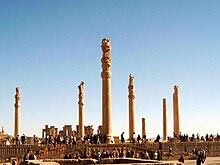
Back عمارة إيرانية Arabic İran memarlığı Azerbaijani ইরানি স্থাপত্য Bengali/Bangla Arquitectura de l'Iran Catalan ГӀажарийн архитектура CE Persische Architektur German Irana arkitekturo Esperanto Arquitectura de Irán Spanish معماری ایرانی Persian Persialainen arkkitehtuuri Finnish



Iranian architecture or Persian architecture (Persian: معمارى ایرانی, Me'māri e Irāni) is the architecture of Iran and parts of the rest of West Asia, the Caucasus and Central Asia. Its history dates back to at least 5,000 BC with characteristic examples distributed over a vast area from Turkey and Iraq to Uzbekistan and Tajikistan, and from the Caucasus to Zanzibar. Persian buildings vary greatly in scale and function, from vernacular architecture to monumental complexes.[2] In addition to historic gates, palaces, and mosques, the rapid growth of cities such as the capital Tehran has brought about a wave of demolition and new construction.
According to American historian and archaeologist Arthur Pope, the supreme Iranian art, in the proper meaning of the word, has always been its architecture. The supremacy of architecture applies to both pre- and post-Islamic periods.[3] Iranian architecture displays great variety, both structural and aesthetic, from a variety of traditions and experience. Without sudden innovations, and despite the repeated trauma of invasions and cultural shocks, it developed a recognizable style distinct from other regions of the Muslim world.[4] Its virtues are "a marked feeling for form and scale; structural inventiveness, especially in vault and dome construction; a genius for decoration with a freedom and success not rivaled in any other architecture".[5]
- ^ "'برج آزادی پس از ۲۰ سال شسته میشود'". BBC News فارسی (in Persian). 18 July 2009. Retrieved 2020-05-13.
- ^ Arthur Upham Pope. Introducing Persian Architecture. Oxford University Press. London. 1971. p.1
- ^ Arthur Pope, Introducing Persian Architecture. Oxford University Press. London. 1971.
- ^ Arthur Upham Pope. Persian Architecture. George Braziller, New York, 1965. p.266
- ^ Arthur Upham Pope. Persian Architecture. George Braziller, New York, 1965. p.266